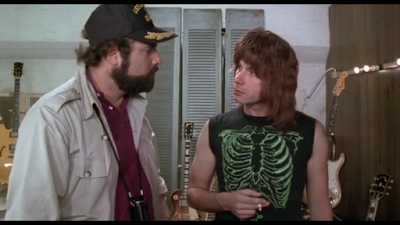 |
| KISS (holograms) love you! |
KISS just wrapped up a 50-year career in typical KISS fashion.
Selling product.
Not content to leave the stage with a remaining shred of dignity intact, KISS left their fans with a message, and a sales pitch: “The new KISS era starts now!” And unveiled the next era of KISS.
Digitally created avatars.
The new beginning? Artificiality.
KISS presumably means to render themselves, and their income streams, immortal. “The band will never stop because the fans own the band,” explained frontman Paul Stanley.
Paying fans, with their money going to KISS in perpetuity.
Fuck I hate the world right now.
***
Artificial entertainment is not unique to KISS. We’re being increasingly inundated with images spun out of DALL-E, text spit from ChatGPT. Fake videos with AI trained voiceovers are making it increasing harder to tell what is real.
Now we’ve got AI KISS. Holograms, programmed to move based on training data, not spontaneity.
A nightmare.
I ask, with earnestness: What is the point?
Before the advent of AI, had you asked me why I liked KISS I would probably have answered “the music."
But now I realize, it was also the band members.
People made the music. Putting aside debate about their actual talent, Gene, Paul, Peter, and Ace blended their unique backgrounds and experiences to write songs. They had several false starts and tentative steps toward their final brand image. It was a messy path of false starts, playing shows in high school gyms in front of a dozen disinterested fans, before they finally hit it big.
The end product was, almost miraculously, pretty awesome, at least from an entertainment perspective.
Paul Stanley is a human being possessed of loves and interests, passions, faults, foibles, and flaws. As were the other members of KISS. Together they wrote great songs and terrible songs. Classic albums and awful clunkers. They did some amazing tours, limped through others, and put out some really shitty merchandise.
I love it all.
I love it because KISS is unique, and every member that served in the band, unique (especially Vinnie Vincent). It’s what makes them entertaining. This humanness is an incalculable part of what makes KISS endearing to its fans.
KISS is easy to pick on, and mock. “They were already artificial!” OK, fair enough. But they were and are real people who against long odds, built a career most would envy.
The next era is a mockery, and its only just begun.
Will AI generated Paul Stanley paint pictures, bang groupies, have children, fight with digital Ace Frehley on Eddie Trunk? Will the band members write ChatGPT generated memoirs about their “tours”? Inspire new AI artists?
Are we supposed to go to concerts and cheer on holograms?
There is no point to AI generated art. It is soulless in every sense of the term. Because there is no soul behind it, not even a ghost in the machine. Just scraped and aggregated data, vectored and served up.
One small bit of good news is that it appears AI generated art is not copyrightable. And it doesn’t deserve to be, because there is nothing worth preserving in it. It is the pinnacle of corporate, Silicon Valley soul-lessness, a golem of circuitry built from the flesh and blood output of real artists.
If we had any sense as a species, AI would be put to use solving actual big problems like climate change and nuclear fusion. Detecting cancers unseen to the naked eye. Or automating soulless, mind-crushing tasks.
To be fair AI is being used in some of these applications. I hope these succeed. But most of the product development is being applied in the creative industries, and white collar businesses.
Why? As with any open question about business, the answer is the same here as with any other: follow the money.
Companies are now rapidly training niche AIs and then selling them as subscription products. Businesses are already outsourcing human labor to machines, reducing overhead expense and increasing their profitability to shareholders.
This is commerce, not art.
Worse, kids are using it to write papers, teachers to grade these fake papers, “creators” to fuel their content pipeline. What are we learning? What is more impressive, a guitar virtuoso who has spent 25 years mastering his craft, a generational talent like Frank Frazetta painting with fire, or some kid putting prompts into DALL-E?
People are the losers in the AI race. As are dignity, hard work, effort, and talent.
So is the future. We’re sacrificing that, too. And we’re making a mockery of the past.
A massive part of the appeal of Conan and Solomon Kane and Kull is its creator, Robert E. Howard. Howard was rooted in Cross Plains, possessed of a voracious reading habit, writing talent, and an imagination as big as Texas. He was complex, contradictory, full of great passions, “giant melancholies and gigantic mirths.” All of it formed the wellspring of his art.
AI has none of this. There is no background to excavate, no influences to explore, no literary legacy to debate, no arguments over places in the pantheon.
AGIs have no history. They never worked on oil fields, felt the sting of lost loves, experienced the alienation of an artistic soul in a town whose residents despised its craft.
AI generated writing is the death knell of literary criticism. How can one say anything about the output of a program, scraping and training itself on massive data sets of already existing content? A hellish, endless loop of sophisticated repetition and large-scale copying, including everything Robert E. Howard ever wrote?
To recap: AI generated art, including images and text, but also AI avatars, AI music, all of it, is void of meaning. It is shallow, empty, and purposeless.
Inhuman.
I will not be part of creating it, or consuming it.
Neither should you.
































